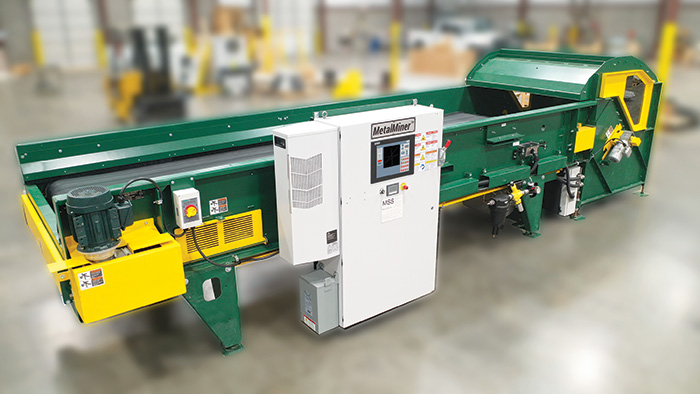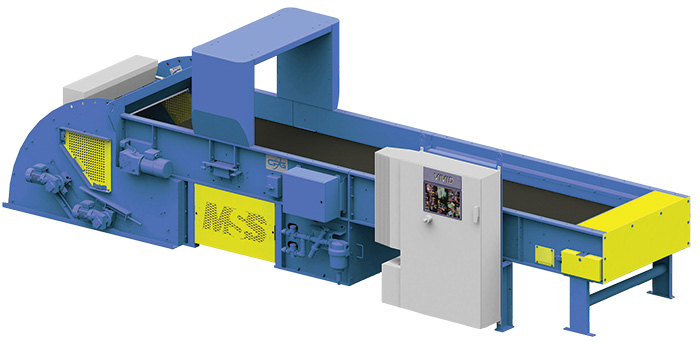
MSS MetalMiner induction sorter to extract residual metals from e-waste. Images courtesy of MSS.
With the two main objectives being the recovery of as much value out of the mixed e-waste and the reduction in manual sorting stations, evolving technologies provide e-waste processors with all the tools at their disposal to achieve those goals…
By Felix Hottenstein
Today’s e-waste processors are facing a myriad of options when evaluating different sensor-based sorting machines that are available in the marketplace. Finding the best technology and the right balance between CAPEX and OPEX, including how to generate the most value from your investment, requires specific know-how that only comes with years of experience on both the equipment hardware as well as on the operations side. Furthermore, the difficulty to find and retain manual labor in the current industry environment has shifted investments towards more and more automation in e-waste facilities throughout North America.
It is the intent of this article to provide readers with a general overview of the available sensor-based sorting technologies for e-waste facilities, organized in order of typically established processing steps.
Mechanical Pre-Processing and Sizing
The most common first step is size reduction to a <2″ size. In many instances, this is accomplished with a single primary shredder. In some larger facilities, a coarse pre-shredder and subsequent magnet are employed upstream of the primary shredder to increase overall system throughput by balancing the workload between the two and reduce wear on the main shredder by removing oversized ferrous times.
The first separation step is the removal of the fines fraction, most often a <3/8″ cut. The <3/8″ fines can be further sorted into ferrous fines, non-ferrous fines (small aluminum, copper, and PCBs) and plastics-rich fines that will contain some wire and precious metals.
In smaller to medium size facilities, the fines removal is the only sizing step. In larger plants we recommend splitting the <3/8″ to 2″ material into two additional sizes (3/8″ to 3/4″ and 3/4″ to 2″) to increase the efficiency of the down-stream sorting equipment. The following described sorting technologies would (obviously) be employed on both additionally sized streams.

MSS eMax NIR optical sorter for recovering plastic resins from e-waste.
MSS L-VIS camera sorter to sort PCBs from mixed metals.Ferrous Recovery and Quality Control
The recovery of the ferrous metals from the mixed e-waste is done by way of magnets. We usually recommend the use of drum magnets for e-waste applications. While more capital intensive compared to over-band belt magnets (inline or perpendicular), the long-termsavings in maintenance and potential belt replacement make up for it in a short amount of time.
In most plants, the quality control of the ferrous stream consists of removing copper and PCBs still attached to ferrous items. Currently, the only way to accomplish this is by manual sorting. While possible from a pure sensor identification standpoint, due to the high weight per surface area of the ferrous items, it would be difficult to use a conventional optical sorter with air jets in this position. However, new developments in AI sensor technology as well as new selective electro-magnetic separators are being introduced to the market to automate this function.
Non-Ferrous Sorting and Quality Control
An eddy-current separator (ECS) extracts the copper, aluminum, and high-grade PCBs from the plastics. Different ECS models (concentric versus eccentric) with varying number of poles, depending on the particle size and vendor recommendations, are used for this function.
The quality control of the generated non-ferrous fraction is crucial to extract the most value out of the material. The high-grade PCBs, copper, and non-metals (pieces of plastics that were mistakenly removed with the non-ferrous particles) all need to be removed from the aluminum fraction.
For high-volume facilities, the non-ferrous QC functions are conducted by optical sorters that combine a high-resolution camera with an induction metal sensor. Depending on the quality requirements for the removed non-aluminum contaminants, a secondary sorting step using the same sensor combination may be required.
In smaller facilities where a manual QC is not an option and space comes at a premium, a smaller AI-sensor based optical sorter can be used which takes up less space. The slower belt speed and narrower conveyor of these types of units (about the size of an ECS) makes them more viable in this application.

MSS eMax NIR sorter for extracting PMMA and LCD from flat panels and monitors.Removal of Residual Metals from Mixed Plastics
The pass fraction from the ECS is a plastics-rich stream that still contains low-grade PCBs, stainless steel, copper wire, and pieces of plastics with screws attached to them. An induction-based metal detector will remove and concentrate all these residual metals into a mixed metal stream. As the plastics represent the largest amount of material by volume, it is important to generate a clean and ready to ship plastics fraction in line and as quickly as possible.
Sorting of Stainless Steel
If stainless steel is to be generated as its own separate commodity from the mixed metals fraction off the induction sorter we recommend using one of the stainless-steel separators that use high-intensity neodymium magnets. While this function could also be conducted by an optical sorter that combines a high-resolution camera with an induction metal sensor, the mechanical solution is less expensive and takes up less room.
Sorting of PCBs
The mixed metals fraction off the induction metal sensor is processed through the high-resolution camera sorter to extract the low-grade PCBs. The operator will have the option to either keep this fraction separate or combine it with the high-grade PCBs off the ECS non-ferrous stream. Using the camera sorter will also give the operator the option to choose whether copper wire is sorted out with the PCBs or as their separate fraction later down the line in a secondary sorting step.
Sorting of Polymers
In e-waste applications where potential target polymers are not black, a near-infrared (NIR) optical sorter can be used to extract those resins. For example, in facilities that process flat panel and monitors, an eMax can be used to segregate PMMA and LCD materials. Unfortunately, NIR sorters cannot sort black plastics by resin. The carbon black colorants absorb all the light and with no reflected NIR spectrum present, a distinction between different black resins is not possible. A few alternative solutions are available in this case:
• While electrostatic separators have been used in this application for several years, an additional size reduction step as well as multiple sorting steps may be required for optimum final product quality.
• Laser spectroscopy-based optical sorters have been used for the sorting of black plastics for a few years, but their high cost has so far prohibited them from being more widely deployed.
• Heavy media separation systems, where different polymers are sorted from each other based on their respective bulk densities, work well for certain polymers, but require additional water treatment/handling as well as drying systems for the generated resins.
Sorting of Flame-Retardant Plastics
If it is required for the processor to sort out flame retardant plastics (mostly brominated compounds) from regular plastics, dual-energy X-ray transmission is the recommended technology for this application.

MSS VIVID AI sensor sorter for ferrous and non-ferrous QCBatch Processing and Optical Sorter Programming Flexibility
In many smaller facilities optical sorters are used offline from the main shredder line to sort out the different commodities listed above in a batch process, simply using different software recipes for every run. For example, a high-resolution camera with an induction metal sensor combo unit can be used to sort out PCBs and copper wire during one run, then sort the wire from the PCBs in the next run. A near-infrared optical sorter can be used to sort out PMMA from mixed plastics in one run, then sort out the LCD material in a second run. The advantage of such a setup is that the capital cost is kept in check as only one optical sorter would be required. However, such a setup requires more storage space and additional material handling to feed and re-feed the batch system with the various generated intermediate products.
Other AI Applications
Besides the above-mentioned applications that could possibly feature AI QC functions, such as ferrous and non-ferrous QC, AI sensor technology could be used for other applications such as sorting out CPUs, memory chips or capacitors from a stream of shredded PCBs that have been size-reduced to a degree where those smaller components have been liberated from the board substrate.
Achieving Your Goals
The sensor-based sorters available to e-waste processors consist of a wide variety of ever-evolving technologies such as induction sensors, high-resolution cameras, NIR, X-ray and AI. With the two main objectives being the recovery of as much value out of the mixed e-waste and the reduction in manual sorting stations, these technologies provide e-waste processors with all the tools at their disposal to achieve those goals. | WA
Felix Hottenstein has been the Sales Director for MSS, Inc. the optical sorting division of CP Group, for more than 24 years. MSS designs and manufacturers optical sorting technology for all areas of the recycling and waste management industry. Felix has a Masters Degree in Material Science Engineering from the Federal Polytechnical Institute in Zurich, Switzerland (ETHZ). He can be reched at (615) 781-2669, e-mail info@mssoptical.com, or visit www.mssoptical.com.
This article originally appeared in the June 2023 issue of Waste Management Magazine
